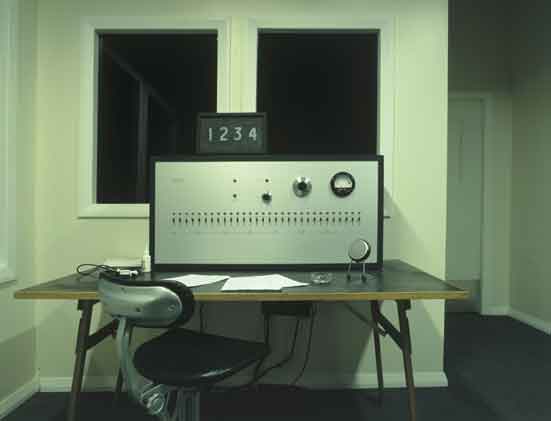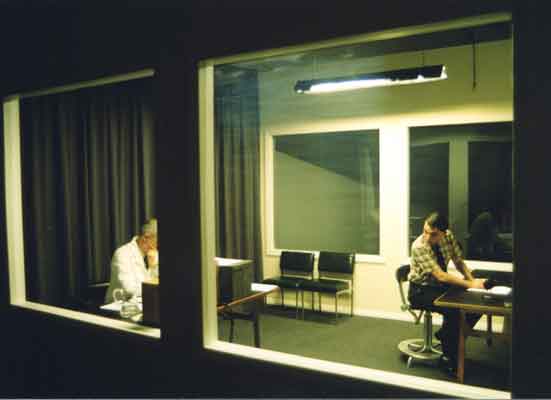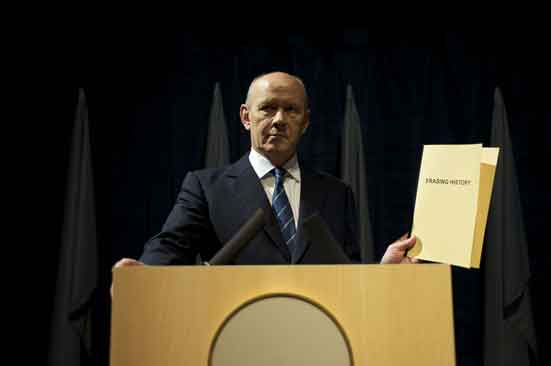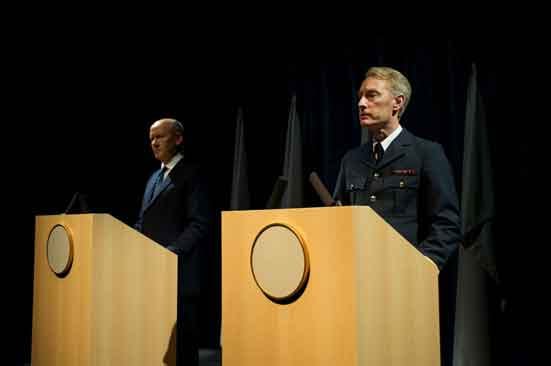Rod Dickinson is currently showing the The Milgram Re-enactment (2002) in the exhibition ‘Scapegoat Society’ at Guest Projects, 1 Andrews Road until 21 February.
At 5pm on Sunday 21 February Rod will give an artist’s talk in the gallery. See www.nornprojects.org for further details.
About the project:
‘The Milgram Experiment’ was a reconstruction of one part of Stanley Milgram’s Obedience to Authority experiment, first conducted at Yale University from 1960.
During the original experiment subjects were asked to give seemingly real electric shocks to another individual. The experiment was designed to test the limit to which subjects were prepared to follow the orders of a scientist. It aimed to establish to what degree an individual would be prepared to hurt a fellow human because they were ordered to do so.
In the original experiment the three protagonists were the Learner, the Teacher, and the Scientist. The Learner and the Scientist were actors and the Teacher was an unwitting subject who had answered an advertisement calling for participants for a learning experiment in a study of memory. The Teacher thought that they were part of a research project that aimed to establish whether punishment could help people to learn. The teacher was instructed to give increasingly severe electric shocks to the Learner if he failed to remember a sequence of words that had been read to him at the beginning of the experiment. In reality no shocks were administered.
The true purpose of the experiment was to establish the degree to which the Teacher was willing to obey the authority of the Scientist. Despite the Learner’s cries of pain (and despite his declaration that he no longer wanted to be a part of the experiment), in the majority of cases the Teacher continued to follow the instructions of the Scientist.’ [Extract from ‘Introduction’ Steve Rushton (ed.) The Milgram Re-Enactment (Maastricht: Jan van Eyck Academie, 2003)]
The forty psychologists Milgram polled in advance believed that less than 1% of the hypothetical subjects would administer the maximum 450 volts shock. In practice 65% of subjects were fully obedient administering the maximum shock until they were told to stop. These statistics are probably some of the most significant in the history of psychology.
The Milgram Re-enactment was performed at the Centre for Contemporary Art, Glasgow on 15 and 17 February 2002. Rod created the work in collaboration with Graeme Edler and Steve Rushton. The re-enactment used identical procedures and equipment to Milgram but this time all the participants were actors.
Ali MacGilp: What prompted you to explore the Milgram Experiment?
Rod Dickinson: At the time I was interested in the sorts of mechanisms that underpin human behaviour and how we might be able to account for seemingly inexplicable. The experiment also interested me because of its reliance on theatre and dramaturgical structures to prove a scientific hypothesis.
AM: You went back to the original source material at Yale University Archive; did anything you discovered there surprise you?
RD: The most surprising thing was that most of this remarkable archive had hardly been accessed for twenty years. Yale told me that no one had taken transcripts of the experiment from the archive for that long. So it really seems that our contemporary knowledge of the experiment is based on snippets of film footage, and Milgram’s own writing, rather than any archive research that anyone has done in the last twenty years.
AM: Milgram was prompted to investigate conformity by his own Jewish heritage and Hannah Arendt's report on the trial of Adolf Eichman: Eichman in Jerusalem, The Banality of Evil. Arendt described the Nazi as a dull, conforming, stereotypical bureaucrat. Milgram took from Arendt that: ‘ordinary people, simply doing their jobs, and without any particular hostility on their part, can become agents in a terrible destructive process. Moreover, even when the destructive effects of their work become patently clear, and they are asked to carry out actions incompatible with fundamental standards of morality, relatively few people have the resources needed to resist authority.’
[Stanley Milgram Obedience to Authority (Harper Colophon 1974) 6 quoted in Steve Rushton (ed.) The Milgram Re-Enactment (Maastricht: Jan van Eyck Academie, 2003) 58].
Milgram concluded that the individual was constructed through institutions and social structures. He saw his results sadly vindicated in the savage behaviour of American soldiers during the Vietnam War.
What is your personal interpretation of the results of the Milgram experiment?
RD: Actually there is some difference between Arendt’s comments about Eichman and Milgram’s findings. Arendt, in her book, in fact does describe Eichman as extraordinary (somewhat contradicting the title, The Banality of Evil). She describes him as being extraordinarily banal. Entirely out of the ordinary in the way that he appeared to think of himself and his actions, which she reports as being uncommonly unimaginative and riddled with clichés.
In a sense Milgram’s experiment tends to assert the erroneously but popularly held version of Arendt’s thesis, that Eichman was a typical sort of everyman and his actions could have been repeatable by anyone.
For me, Milgram’s experiment marks a palpable and demonstrable shift in the way we understand ourselves as humans. In a sense I think that this is its importance and its continuing resonance. We are still really coming to terms with reformulation of the self that contemporary philosophy has been building since the fifties. From Foucault all the way back to Norbert Wiener modern thought has increasingly reconceived the person as being rebuilt around technical and social systems. These ideas are concisely articulated by Katherine N Hayles’ brilliant book ‘How We Became Post Human’. Milgram’s experiment seemed almost to be the first moment that these ideas became visible and experiential, rather than written and discursive.
AM: The Milgram experiment is considered problematic by scientists because of its unethical use of deception. Your work highlights the less well-known microcosm of human drama and anxiety that was played out repeatedly in the experiment and conveys the ethical dilemma of social experience. You have pointed out that its tight script and structures of control and repetition are more akin to theatre.
Milgram fine-tuned proceedings in order to elicit a specific set of responses from his subjects. He constructed an all-encompassing alternate reality for his subjects with its own set of rules and objectives. This situation, where the Scientist promised to take responsibility for anything that happened, made the subjects overcome their moral uncertainty over what they were asked to do. It is the moments when the subject rebel against the system and assert their humanity that are so arresting and make you wonder how you would really react in a similar situation. This takes you beyond your initial response to reading the statistics and thinking ‘I would never do that’.
You mentioned to me that you see Milgram more as a playwright in the mould of Samuel Beckett that a scientist, could you expand?
RD: I think he was a brilliant dramatist – probably a much better dramatist than a scientist. The experiment sets up a drama that, like some of Beckett’s plays, gains gravity and resonance through repetition.
The repetition also increasingly abstracts that drama, the repetition literally numbing us to the sound of the simulated execution.
The resonance of the situation that Milgram orchestrated seems to literally echo through history – so that perhaps the endless buzz of the shock machine and the chanting of those blank, nonsensical word pairs stand not just for the repetition of automatic, obedient behaviour but also for the trauma that this behaviour has iterated through history.
It seemed to me tragic that this extraordinary drama had never had a proper audience. Only Milgram and his assistant saw it live from behind the surveillance windows (like my audience) and Milgram’s own film of the experiment is very informational and focuses on an explanation of the structure of the experiment and on the minority of subjects who resisted. In this sense it is quite different to the re-enactment, which is in real time, experiential and represents the full range of Milgram’s subjects.
AM: In the Milgram Re-enactment your actors were performing the archive of the original experiment. You were not seeking to create new data, as was the case with Artur Zmijewski’s Repetition (2005) a re-enactment of the Stanford Prison Experiment that produced similar results to the original. Why do you feel artist’s re-enactments have become popular of late?
RD: I think it is rarely useful to categorise artworks in this sort of way. Very often the works are exploring very different terrain even if they appear to be similar. So I tend to resist the idea of the popularity of re-enactments. For example Zmijewski’s Repetition is not so much a re-enactment but a re-run of the experiment. In 2000 when I was doing the research for the Milgram piece I decided to not take what I thought was the most obvious route – of ‘re-doing’ the experiment – finding new subjects, making new scientific data from a new experiment - essentially trying to prove or disprove Milgram’s hypothesis. I decided that I wanted to examine the experiment from a different perspective – and one afforded by an art institution, whose daily business, is after all not generating scientific statistics, or data – but to look at and think through processes of representation and mediation.
AM: How did having a live audience affect the development of The Milgram Re-enactment?
RD: It was fundamental to wanting to reconstruct the experiment from the transcripts. My aim was to literally re-animate the archive; live, in real time and real space. I also wanted to create a situation where the audience was forced to become both voyeurs and witnesses. I also requested that audience members not leave the performance / gallery space for the duration of the piece – the whole four hours – in the hope that their predicament would echo that of the subject who was effectively also trapped in front of the shock machine.
AM: Tell me about your recent project: Who, What, Where, When, Why and How presented in Amsterdam in July 2009 which is concerned obliquely with the wars in Afghanistan and Iraq?
RD: This was a live performance that was based on, and simulated, a government press briefing and was performed at SMART project Space in Amsterdam in July last year (2009).
It was set in a meticulously constructed press briefing, with flags, lecterns and all the paraphernalia you would expect at that kind of event. Two actors delivered a forty minute script composed solely of fragments of press statements from the Cold War onward. The speeches were drawn from sources as diverse as Lyndon Johnson, Margaret Thatcher and Slobodan Milosevic and the fragments focused on the way in which almost identical, highly emotive rhetoric has been reused again and again to create consent for acts of state sanctioned violence.
The script is woven together from these fragments irrespective of their context and date – in fact the only change that Steve Rushton and I made to the original material was to remove any specific mention of people, places and dates - but their provenance was made simultaneously evident to the audience in the live event via synced autocue text scrolling up two and a half metre screens on both sides of the audience.
As with the Milgram piece I am also interested in exposing the theatricality and mechanics of the event – here with the use of these visible autocues that would normally be small transparent Plexiglas.
This piece was filmed and photographed and the cameras were deliberately in evidence during the event, partly obscuring the audience’s view at times. These types of briefing events – often called ‘photo opportunities’ in the 60s and 70s are clearly staged for the cameras. Their live-ness is dependent on being mediated.
Television and the moving image have long shaped not only how dramatic events such as conflicts and crises are perceived, but also how and if they happen. The press statement is part of that mechanism, where it is carefully constructed for the template of television and current affairs programmes which disseminate it, and which in turn shape political and social reality.
Although the backdrop to our current political situation is a war in Afghanistan I hope this piece explores more general and prevalent tropes of language and the way in which they construct our world.
Further information:
See http://www.roddickinson.net and http://www.milgramreenactment.org for more information on Rod’s practice and the Milgram Re-enactment. Rod is also a senior lecturer in Media and Cultural Studies at The University of West England.
Ali MacGilp

The Milgram Re-enactment, 2002, Rod Dickinson in collaboration with Graeme Edler and Steve Rushton

The Milgram Re-enactment, 2002, Rod Dickinson in collaboration with Graeme Edler and Steve Rushton

'Who, What, Where, When, Why and How', 2009, Rod Dickinson in collaboration with Steve Rushton

'Who, What, Where, When, Why and How', 2009, Rod Dickinson in collaboration with Steve Rushton